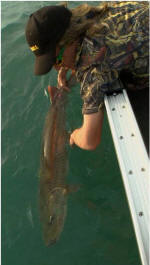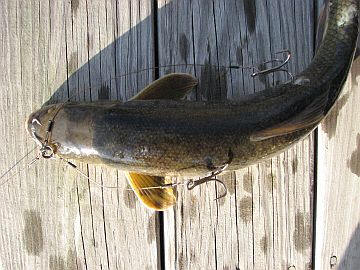
Muskie Fishing
Ontario Muskie Fishing
The Next
Bite
Ontario Fishing Trips
|
 Live
Baiting Muskies Live
Baiting Muskies
by Pete Maina
 Live
bait fishing is not often the first technique
that pops into an anglerís head when thinking
about muskie fishing. However, under certain
conditions it can be the absolute best way to
go, particularly in the cool water periods of
early spring, late fall, or in severe cold front
situations. Live
bait fishing is not often the first technique
that pops into an anglerís head when thinking
about muskie fishing. However, under certain
conditions it can be the absolute best way to
go, particularly in the cool water periods of
early spring, late fall, or in severe cold front
situations.
Every season, many nice muskies are taken using
live bait, with the occasional bonus of a big
pike. However, there are some serious
precautions an angler must take when using live
bait as there is tremendous potential to kill a
lot of fish. Thankfully, though, this has taken
a real turnaround in the last few years. More
education and peer pressure is needed to
eliminate mortality caused by live bait
completely, but things are certainly headed in
that direction. And, the good news is, it is
possible to achieve 100% releasability with live
bait, if some simple rules are followed.
Realize that if you allow esox to swallow the
hook, you have killed them, and this includes
undersized fish too. Live baits (and any
deadbaits for that matter) must be used with
quick-strike rigging. To insure a clean release
(and to increase hooking percentages) immediate
hooksetting is a must.
In choosing good live baits (we'll focus on
suckers because they are the predominate live
bait used for pike and muskies) for quick-strike
use, baits ranging in size from 12 to 17 inches
are the easiest to manage when it comes to
handling the bait and installing the rigging.
They provide a good-sized target that will
attract a large size range of esox, including
those of exceptional size. Smaller baits can
work too, though, as can larger baits. And
sometimes you are left without a choice, due to
availability.
There are several different types of
quick-strike rigs on the market these days. It
still seems that the majority of these
incorporate a leader system on which there is an
adjustable front hook (either treble or single)
to be attached to the front of the bait (usually
the lip) and then a stinger hook or hooks in the
rear. There are also a couple of rigs that have
a rubber band system that eliminates any
necessity for a front hook. A rubber band system
provides more built-in safety for the fish and
better hooking percentages. The key to
quick-strike rig effectiveness is in the whole
rig breaking free cleanly from the bait, and
then into the mouth of the fish.

 Once
the critter has been rigged, there are lots of
ways to present baits. They can be vertically
presented over the side of the boat, which works
very well on breaklines and for any deeper
situations. They can also be suspended below a
float (bobber) to run over vegetation or other
shallow structure. Concentrate on edges with
live bait though, since this truly seems to be
where it is most effective. Once
the critter has been rigged, there are lots of
ways to present baits. They can be vertically
presented over the side of the boat, which works
very well on breaklines and for any deeper
situations. They can also be suspended below a
float (bobber) to run over vegetation or other
shallow structure. Concentrate on edges with
live bait though, since this truly seems to be
where it is most effective.
Finally, hooksets are very important for success
with these rigs. Heavy tackle is a must. You
must have enough force and snap to break the rig
free from the bait and drive the hooks into the
fish. Use a quality, low-stretch super braid
line in a minimum of 80 pound test. Set the hook
hard, with snap, as soon as you can.
Using these rigs, with proper rigging and
setting the hook as described, it is possible to
hook well over 80% of the fish that take, and
they'll be totally releasable. If you set
immediately, hooks will always be in the mouth.
It can work when other methods don't, and its
fun too. Do it right and it's a neat method. Do
it wrong though, and you kill fish!

As mentioned above, heavy tackle is a must when
bait fishing for muskies and pike. Beefy
heavy-action rods in the 7 to 8 foot range and
no-stretch braided line in the 80 to 100 pound
test class are ideal. Tackle like this ensures
you can break the quick-strike rig free of the
bait and drive the hooks home when you set the
hook. Iíve come to rely on lines like Spiderwire
Stealth in 100 or even 150 pound test to get the
job done. The heavy line holds up well to the
hard hooksets needed to make these quick-strike
rigs work.
If you choose to tie up your own quick-strike
rigs, as many anglers do, Iíd suggest making
them with nothing less than 90 pound test
Sevenstrand uncoated wire. This stuff is tough,
yet very flexible and is a great leader and
quick-strike rig material.
 
 Check out Petes Podcasts here!
Check out Petes Podcasts here!
|